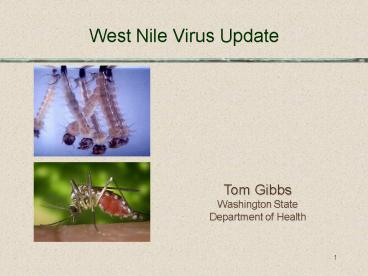West Nile Virus Update - PowerPoint PPT Presentation
1 / 36
Title:
West Nile Virus Update
Description:
Mosquito Control. 25. WNV Surveillance 2003. Dead birds. Especially crows, jays, magpies ... Wear long sleeves & pants in mosquito-infested areas ... – PowerPoint PPT presentation
Number of Views:73
Avg rating:3.0/5.0
Title: West Nile Virus Update
1
West Nile Virus Update
Tom GibbsWashington StateDepartment of Health
2
WNV in the U.S.
3
WNV Background
- First isolated from in the West Nile District of
Uganda, 1937 - Recognized as a cause of inflammation of the
spinal cord and brain with outbreak in elderly
patients, Israel, 1957 - Equine disease noted in Egypt and France in the
early 1960s - 1999 Old World virus arrives in the New World
4
WNV Outbreaks
- Israel - 1951-1954, 1957, 2000-2002
- France 1962, 2000
- South Africa - 1974
- Romania 1996
- Italy 1997
- Russia - 1999
- United States 1999-2003
5
Timeline
Encephalitis Condition Identified
Equine Disease Identified
Israel 1957
Uganda 1937
Israel 1951-54
France 1962
South Africa 1974
Romania 1996 Italy 1997 Russia 1999 US
1999-2003 Israel 2000-2002 France 2000
6
Transmission Cycle
Incidental infections
Mosquito vector
Incidental infections
Bird reservoir hosts
7
Related Viruses
The Japanese Encephalitis Serocomplexof the
Family Flaviviridae, 1999
8
WNV in the U.S.
- Some Speculated Pathways of Introduction
- Human-transported bird
- Illegal (Black market exotics)
- Legal (zoos legitimate breeders)
- Human-transported mosquitoes
- Storm-transported bird
- Intentional introduction (terrorist event)- not
likely - Infected human traveler- not likely
9
The Disease
- Symptoms
- High Fever
- Headache and body aches
- Skin rash
- Swollen lymph glands
- Neck stiffness
- Disorientation
- Convulsions
- Incubation period
- Generally 3-14 days (following a bite from an
infected female mosquito)
10
Cumulative Distribution of WNV in the United
StatesBefore 1999
States with WNV (0)
11
Cumulative Distribution of WNV in the United
StatesNovember 1999
States with WNV (4)
12
Cumulative Distribution of WNV in the United
StatesNovember 2000
States with WNV (12) DC
13
Cumulative Distribution of WNV in the United
StatesNovember 2001
States with WNV (27) DC
14
Cumulative Distribution of WNV in the United
StatesNovember 2002
States with WNV (43) DC
15
Cumulative Distribution of WNV in the United
StatesOctober 2003
States with WNV (46) DC
16
2003 WNV Activity(As of October 29, 2003)
17
WNV Prevalence 2002 2003
18
Case Summary
As of October 29, 2003
19
Demographics Mortality United States, 1999-2002
20
WNV Cases Weekly 2003 (U.S.)
21
(No Transcript)
22
Analysis of WNV Cases by Age(Colorado)
23
(No Transcript)
24
Protecting the Publics Health
- Surveillance
- Personal Protection and Education
- Mosquito Control
25
WNV Surveillance 2003
- Dead birds
- Especially crows, jays, magpies
- Mosquitoes
- Captive sentinels (e.g. chickens)
- Veterinary surveillance
- Human surveillance
26
EVS Mosquito Traps
Packed with dry ice in preparation for trapping.
27
EVS Mosquito Traps
Setting the trap in proper location
28
EVS Mosquito Traps
In operation
29
WNV Mosquitoes in Washington
30
Estimated Sensitivity of WNV Surveillance Methods
Human cases
Veterinary cases
Mosquitoes
Disease Activity
Sentinel hosts
Dead birds
Time
31
Personal Protection
- Wear long sleeves pants in mosquito-infested
areas - Use repellant containing DEET (N,N-diethyl-3-methy
lbenzamide) and follow directions carefully - Limit outdoor activities at dawn and early
evening - Repair holes in door window screens
32
Habitat Reduction
- Eliminate standing water (flower pots tires
wheelbarrows wading pools) - Change the water in birdbaths at least weekly
- Aerate and chlorinate swimming pools and hot
tubs cover if possible - Consider mosquito-eating fish for your pond
- Keep gutters clean to prevent standing water
- Spread the word educate your friends and
neighbors
33
Revising
34
Washingtons Response
- Statewide mosquito-borne disease response plan
- guidance for state/local agencies and
organizations - response protocols for disease-related events
- tiered response based on severity
- recommendations on public information and
education, surveillance and control - Re-establish, develop new partnerships
- Conduct ongoing training
35
Want More?
- Web Resources
- www.doh.wa.gov/WNV
- www.cdc.gov
- environmentalrisk.cornell.edu/wnv
36
That's All, Folks!































